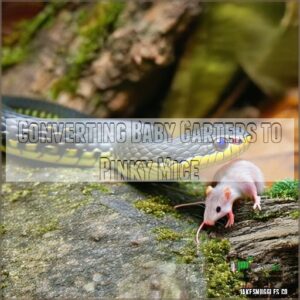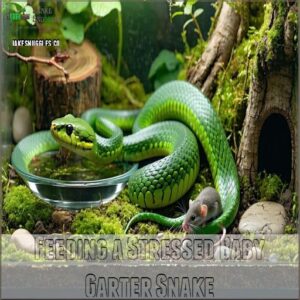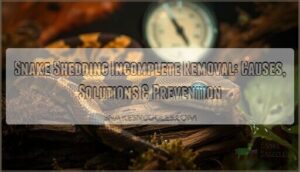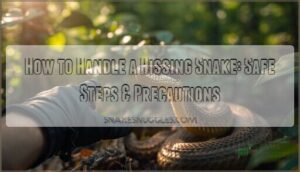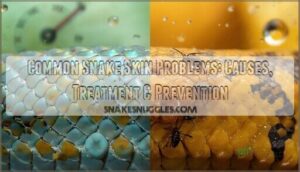This site is supported by our readers. We may earn a commission, at no cost to you, if you purchase through links.
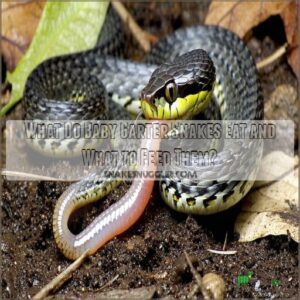
Initially, you’ll need to provide them with small fish fillets or chopped earthworms every other day.
As they grow, offer feeder guppies or minnows every 2-3 days.
Adequate habitat with hiding spots, climbing toys, and a temperature gradient is essential for digestion.
However, teaching hatchlings to recognize prey can be challenging.
Switching them to pinky mice, which are affordable and wholesome, may be ideal.
With proper acclimation, most readily accept pinkies, preventing failure to thrive.
For detailed baby garter snake feeding guidance, let’s explore further.
Table Of Contents
- Key Takeaways
- What Do Baby Garter Snakes Eat and What to Feed Them?
- What Do Baby Garter Snakes Eat?
- Feeding Challenges With Baby Garter Snakes
- Converting Baby Garters to Pinky Mice
- Feeding Procedure for Baby Garter Snakes
- What Baby Garter Snakes Need to Survive
- Raising Baby Garter Snakes
- Feeding a Stressed Baby Garter Snake
- Feeding a Recovering Baby Garter Snake
- Frequently Asked Questions (FAQs)
- What can I feed my baby garter snake?
- What do baby garter snakes need to survive?
- Can you raise a baby garter snake?
- What to feed a tiny baby snake?
- How often should baby garter snakes be fed?
- Can baby garters eat insects or amphibians?
- What size enclosure is best for baby garters?
- How do you acclimate captive-bred baby garters?
- What are signs of dehydration in baby garters?
- Conclusion
Key Takeaways
- Hey there, little snake parent! Get ready for a wild ride! Feeding those tiny garter snakes can really test your patience and creativity. But don’t worry, with the right approach, you’ll have those little noodles thriving in no time!
- Here’s the scoop: when they’re fresh out of the egg, those little guys will happily munch on some small fish fillets or chopped up earthworms. But as they grow, you’ll want to upgrade to feeder guppies, minnows, or even pinky mice! Just like transitioning a toddler to solid foods, it can be a bit of a challenge at first.
- Now, I won’t lie to you – getting those stubborn little snakes to recognize and accept their new diet can be a real headache. They might turn their noses up at those delicious pinkies at first. But trust me, with a little perseverance and some scent training tricks (like rubbing that prey with some fishy oils), you’ll get them hooked in no time!
- And listen, I get it – raising these little guys from hatchlings is no walk in the park. You’ve got to create the perfect environment, with the right temps, humidity, and hiding spots. It’s like setting up a five-star hotel for your scaly guests! But hey, that’s all part of the fun, right? Just take it one day at a time, and before you know it, those tiny garters will be thriving adults!
What Do Baby Garter Snakes Eat and What to Feed Them?
Baby garter snakes primarily eat small invertebrates like worms, insects, and slugs in the wild. When starting to feed baby garter snakes, it’s essential to understand their feeding frequency, such as feeding every 5-7 days, according to the baby snake feeding schedule. To feed baby garter snakes in captivity, it’s best to start them on appropriately sized live feeder insects or pinky mice.
What Do Baby Garter Snakes Eat?
Juvenile garter snakes primarily feed on small fish, earthworms, and other invertebrates in the wild. As they mature into adults, garter snakes switch to a diet consisting mainly of small rodents, amphibians, and occasionally bird eggs or nestlings.
Juvenile Garter Snakes
You’ll want to feed baby garters:
- Fish fillets or chopped earthworms every other day
- Feeder guppies or minnows every 2-3 days
- Provide a shallow water bowl and humid substrate
Their small size makes proper feeding essential. Offer climbing toys and hiding spots to reduce stress during meals. A set temperature gradient is also important for digestion.
Adult Garter Snakes
An adult garter snake’s diet differs from juveniles. You’ll want to feed them:
- Small rodents (once a week)
- Frozen/thawed pinkies or fuzzies
- Avoid live rodents to prevent injury
- Offer rodents with tongs or hemostats
- Provide proper caging, heat, and humidity
Providing the right environment and diet is essential for their longevity and overall health.
Feeding Challenges With Baby Garter Snakes
You’ve probably realized by now that feeding baby garter snakes can be quite challenging. Here are some common issues you may face: – Whole fish and worms may be too large or expensive for frequent feedings
- Babies don’t always recognize worm pieces or fish fillets as food
- They need to eat twice a week, requiring a large supply of live prey
- Lack of proper food can lead to weight loss and potential death
To overcome these hurdles, you’ll need patience, creativity, and potentially a shift to an alternative food source like pinky mice. With the right approach, you can guarantee your baby garters thrive during this delicate life stage.
Converting Baby Garters to Pinky Mice
Converting baby garters to pinky mice is advantageous for several reasons:
- Pinkies are cheaper and more available than fish or worms
- They’re a wholesome, nutritious food source for growing snakes
- Even tiny pinky parts are suitable for hatchlings
- Pinkies prevent weight loss and failure to thrive
However, you may encounter resistance initially. Some garters stubbornly refuse mice, no matter how delectable. But persevere – the benefits make changing worthwhile. With proper acclimation, the vast majority accept pinky mice readily, thriving on this cost-effective, easily obtained diet. Just make sure appropriate temperature, substrate, and tank setup to encourage acceptance.
Feeding Procedure for Baby Garter Snakes
For efficient baby garter snake feeding, follow this proven procedure:
- Separate snakes to prevent fighting and cannibalism
- Use deli cups to contain each snake during feeding
- Place the appropriate food items in the cups
- Carefully put the snakes into their designated cups
- While they’re eating, clean and rearrange their habitat
This deli cup method allows you to:
- Monitor each snake’s intake
- Avoid potential injuries
- Tidy up their living space
- Reduce stress during mealtimes
What Baby Garter Snakes Need to Survive
To help baby garter snakes survive, provide:
- A secure, escape-proof enclosure
- Proper temperatures (75-85°F gradient, 95°F basking)
- Appropriate humidity levels (40-60%)
- Hiding spots for security
These little hatchlings are delicate, so creating the right environment is key. Once basic needs are met, you can focus on feeding. Baby garters require small meals every 2-3 days – think tiny fish, worms or pinky mice parts. Be patient; getting them eating can take time. With care and consistency, these miniature marvels will thrive under your watchful eye.
Raising Baby Garter Snakes
Once you’ve mastered proper feeding, raising baby garters requires continued care and patience. Their growth rate varies, so track their size and adjust portions accordingly. While social and generally hardy, isolate any aggressive individuals as these snakes can cannibalize one another.
- Monitor for respiratory issues, mouth rot, or parasites
- Avoid stressing them with excess handling
- Let them settle for a few weeks after rehousing
- Consider breeding pairs once females reach 2-3 years old
- Prepare for potential egg-binding complications
With attentive husbandry, your baby garters will thrive into adulthood. Raising these fascinating reptiles is an immensely rewarding experience for the dedicated hobbyist.
Feeding a Stressed Baby Garter Snake
You’ve found your baby garter snake is stressed and refusing food – a common challenge. First, create an ideal environment:
- Warm basking spot around 95°F
- Mild UVB lighting
- Plenty of hiding spots and foliage
- Large water bowl
Then, try these scent-training feeding techniques:
- Rub prey items like crickets or pinkies with fish oils or frog scent
- Offer lively prey like minnows or nightcrawlers
- Use tongs to wiggle prey near the snake’s face
- Be patient – it may take multiple attempts
With proper habitat and persistence in offering varied live prey, your stressed garter should regain its appetite.
Feeding a Recovering Baby Garter Snake
Now that your garter snake has recovered, it’s time to introduce an appropriate diet. Here’s what to do:
- Offer a variety of prey items such as small fish, nightcrawlers, and appropriately-sized frozen/thawed rodents.
- Provide calcium and vitamin supplements once or twice a week by lightly dusting the prey.
- Feed juveniles every 5-7 days and adults every 7-10 days to prevent obesity.
- Monitor for signs of dehydration and provide a clean water bowl at all times.
Variety, proper supplementation, and appropriate feeding frequency are essential for a balanced diet and healthy growth. Be patient and persistent – your garter will soon adapt to its new routine.
Frequently Asked Questions (FAQs)
What can I feed my baby garter snake?
Feeding frugal frogs – primarily pinky mice pieces – provides perfect protein portions for petite pythons. Precisely portion pinkies properly, preventing pudgy pets.
What do baby garter snakes need to survive?
For baby garter snake survival, provide a varied diet of appropriately sized feeder fish, worms, or pre-killed rodents; a secure enclosure with proper heating and hiding spots; and minimal handling to reduce stress. Regular, attentive care is vital in their fragile early stages.
Can you raise a baby garter snake?
You can raise a baby garter snake, but it requires dedication. Provide proper housing, heating, and humidity. Be patient when introducing food, as they may refuse at first. With care and consistency, these fascinating reptiles can thrive under your supervision.
What to feed a tiny baby snake?
You may have heard stories about fussy eaters, but knowing that garter snakes are obligate carnivores relying on animal-based food, baby garter snakes are notoriously difficult to get started on food. It’s imperative to find a nutritious diet they’ll accept to guarantee their survival and healthy development.
How often should baby garter snakes be fed?
Baby garter snakes should be fed every 2-3 days. Their small size and rapid growth require frequent, nutrient-dense meals to avoid failure to thrive.
Can baby garters eat insects or amphibians?
Like a chameleon blending into nature, baby garters can eat appropriately-sized insects and amphibians, though proper nutrition is key for ideal growth.
What size enclosure is best for baby garters?
For baby garter snakes, a 10-gallon tank or plastic storage container offers suitable space. Make sure it has secure ventilation, a warm basking area, and ample hiding spots as they grow rapidly in their first year.
How do you acclimate captive-bred baby garters?
Picture baby garters curiously exploring their new home. Gently introduce environmental elements—hides, foliage, proper temperatures—allowing snakes time to acclimate and destress before attempting feedings.
What are signs of dehydration in baby garters?
Signs of dehydration in baby garters include sunken eyes, wrinkled skin, lethargy, and increased respiratory rate. Maintain adequate humidity, provide clean water, and mist the enclosure as necessary. Early detection is paramount for their survival.
Conclusion
Ultimately, baby garter snakes thrive on a diet of pinky mice, allowing for balanced nutrition and growth.
Properly feeding young garters establishes a strong foundation, preventing failure to thrive and facilitating their passage to adulthood.



